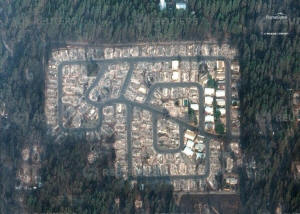|
Expected rains could hinder search for
California wildfire victims
 Send a link to a friend
Send a link to a friend
 [November 20, 2018]
By Jonathan Allen and Nick Carey [November 20, 2018]
By Jonathan Allen and Nick Carey
(Reuters) - Heavy rains are expected in
northern California on Tuesday, raising the risk of mudslides and
hindering the search for more victims of the deadliest wildfire in the
state's history as nearly 1,000 people remain listed as missing.
Remains of 79 victims have been recovered since the Camp Fire erupted on
Nov. 8 and largely obliterated the Sierra foothills town of Paradise, a
community of nearly 27,000 people about 175 miles (280 km) north of San
Francisco.
The missing persons list kept by the Butte County Sheriff's Office still
has 993 names on it. That number has fluctuated dramatically over the
past week as additional people were reported missing, or as some
initially listed as unaccounted for either turn up alive or are
identified among the dead.
Sheriff Kory Honea has said some people have been added to the list more
than once at times under variant spellings of their names.
As of Monday, the fire has torched more than 151,000 acres (61,100
hectares) of parched scrub and trees, incinerating about 12,000 homes
along the way, Cal Fire said.

Containment lines have been built around 70 percent of its perimeter,
according to the agency.
Efforts to further suppress the flames were likely to benefit from a
storm expected to dump as much as 4 inches (10 cm) of rain north of San
Francisco between late Tuesday and Friday, said Patrick Burke, a
National Weather Service forecaster.
'MUDDY, MUSHY MESS'
But heavy showers risk setting off mudslides in newly burned areas while
also making it more difficult for forensic teams sifting through cinders
and debris for additional human remains.
Colleen Fitzpatrick, founder of the California-based consulting company
Identifinders International, said rain would turn the site into a
"muddy, mushy mess", slick with wet ash.
Pathologists from the University of Nevada, Reno worked through the
weekend as firefighters peeled back debris, collecting bits of burned
bones and photographing everything that might help identify victims.
[to top of second column]
|

DigitalGlobe satellite image shows fire damages in the Kilcrease
circle community aftermath of the Camp Fire in Paradise, California,
U.S. on November 17, 2018. Courtesy Satellite image ©2018
DigitalGlobe, a Maxar company/Handout via REUTERS

The risk of mudslides could also increase the misery of the
evacuees, some of whom are living in tents or camping out of their
cars. Residents who only recently were permitted back in homes that
survived the fire may be ordered to evacuate again if they live
downslope from badly burned areas.
Intense fire over the slopes of canyons, hills and mountains makes
them more prone to landslides, by burning away vegetation and
organic material that normally holds soil in place. The fire also
creates a hard, waxy surface that tends to repel rather than absorb
water.
The result can be heavy runoff of rainwater mixed with mud,
boulders, trees and other debris that flows downhill with tremendous
force, said Jason Kean, a research hydrologist for the U.S.
Geological Survey.
"Those debris flows have the consistency of wet concrete and move
faster than you can run," he said. "It's like a flood on steroids
... and a big one can take out two-story buildings."
The number of residents needing temporary shelter was unclear, but
as many as 52,000 people were under evacuation orders at the height
of the firestorm last week.
Nearly 500 miles south of Paradise near Malibu, west of Los Angeles,
at least two inches of rain are expected to fall on a second fire,
the Woolsey, which has killed three people. That blaze was 94
percent contained by Monday morning.
The cause of both fires is under investigation, but electric
utilities reported localized equipment problems around the time they
broke out.
PG&E Corp <PCG.N> has said it could face liability that exceeds its
insurance coverage if its equipment were found to have caused the
Camp Fire.
(Reporting by Brendan O'Brien in Milwaukee; editing by David Stamp)
[© 2018 Thomson Reuters. All rights
reserved.]
Copyright 2018 Reuters. All rights reserved. This material may not be published,
broadcast, rewritten or redistributed.
Thompson Reuters is solely responsible for this content.
 |